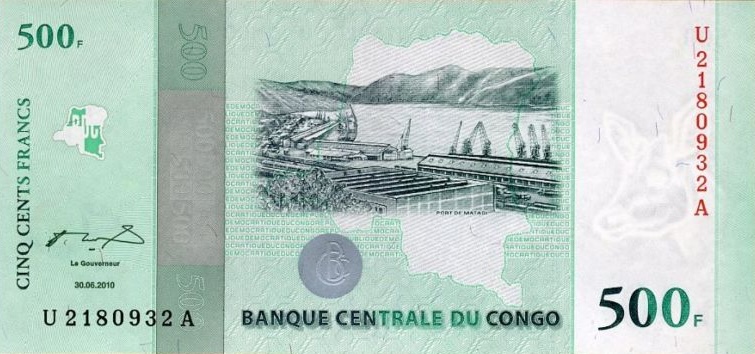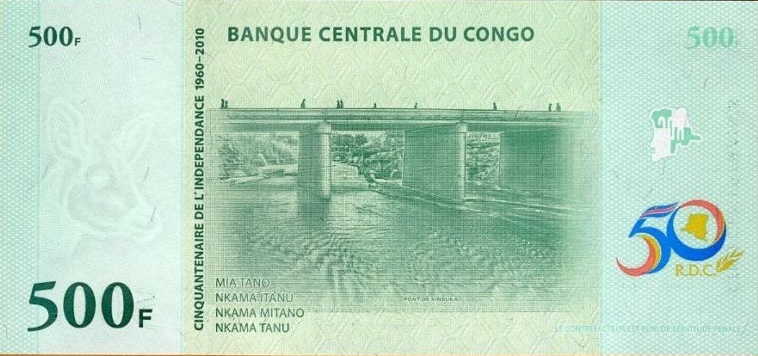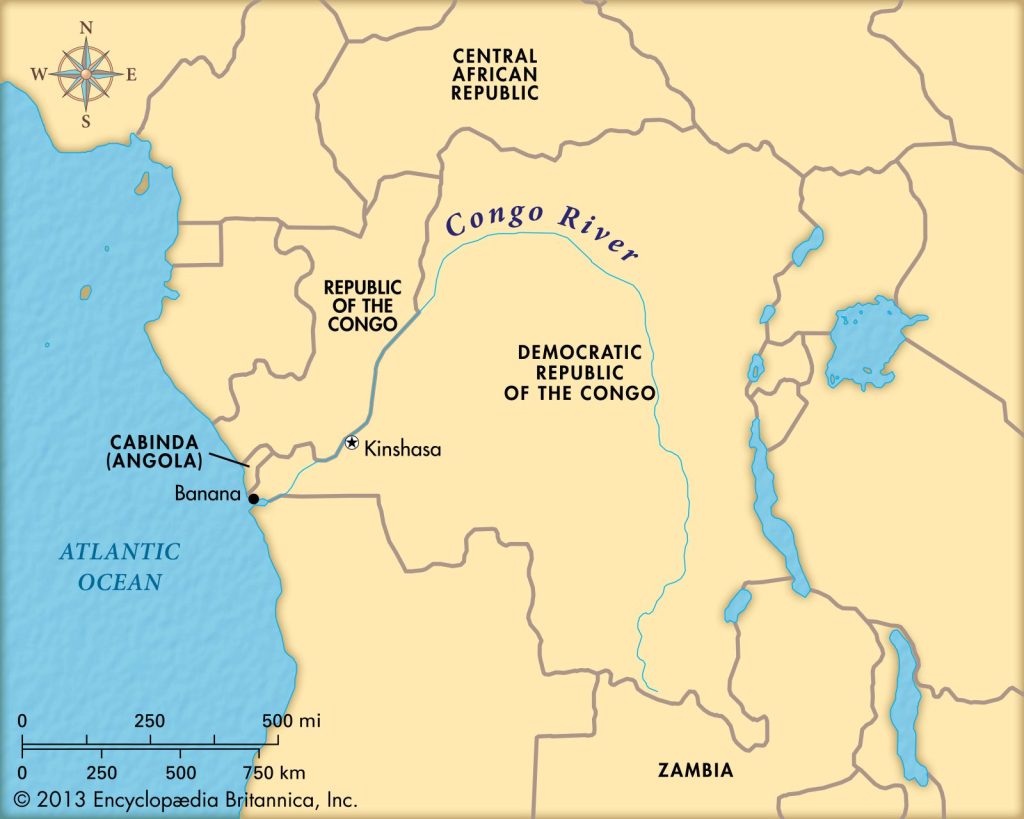The 2010 Commemorative 500 Francs Banknote of the Democratic Republic of the Congo: A Reflection of Heritage and Progress
Listening to the story of the banknote is a column created by the CBN Editorial Board to analyze and rewrite the reasons for the banknote’s existence. The column also goes into depth about the banknote, bringing values about the culture, history, life, and people of a country that the banknote itself is responsible for.
In this commemorative 500 Francs banknote, the Democratic Republic of the Congo artfully blends its historical narrative, infrastructural achievements, and deeply rooted cultural identity. Each featured element—from the Port of Matadi to the Kinsuka Bridge and the vast Congo River—tells a story of endurance, unity, and ever-evolving progress. Through these images, the currency not only reflects the nation’s heritage but also reaffirms its aspirations for a more connected and prosperous future.

In the late 19th and early 20th centuries, the vast territory of the Congo endured a harsh colonial regime under Belgian rule. Exploited for its abundant natural resources—rubber, minerals, and ivory—Congolese populations suffered forced labor and oppressive governance. Widespread discontent and a growing nationalist sentiment led to the emergence of influential political figures who demanded self-determination. Leaders such as Patrice Lumumba and Joseph Kasa-Vubu became vocal advocates for the Congolese cause, echoing widespread calls for liberty and an end to systemic injustices.
As the winds of decolonization swept across Africa, the Congo stood on the frontline of this historic shift. Despite ongoing challenges with unity, tribal alliances, and struggles for political representation, the Congolese people persisted in their quest for sovereignty. Finally, on June 30, 1960, the Congo gained independence from Belgium, ushering in a new era of possibility. The inaugural government attempted to redefine the country’s identity, establishing local institutions and placing Congolese citizens at the helm of their nation’s future.
However, the immediate post-independence period was fraught with internal power struggles, which eventually culminated in armed conflicts and political upheavals. Yet, even amid tumult, the bold spirit of June 30, 1960, resonated as a symbol of hope. It affirmed the Congolese aspiration to control their destiny and champion the dignity of their people, a sentiment that endures to this day and is poignantly commemorated on the 2010 500 Francs banknote.
Prominently featured on the 2010 Commemorative 500 Francs banknote, the Port of Matadi is far more than a picturesque riverside harbor—it is a crucial economic lifeline and a testament to the Democratic Republic of the Congo’s resilience. Strategically located on the banks of the Congo River in Kongo Central Province, Matadi has served for decades as the country’s principal sea gateway, linking inland cities with international trade routes.

Historically, its significance can be traced back to the colonial era, when Belgium recognized the site’s potential for shipping commodities such as rubber, copper, and other valuable resources. While the port first emerged under less-than-ideal circumstances—largely catering to Belgium’s industrial interests—it gradually became a pillar of the national economy. Today, Matadi’s facilities handle the majority of the DRC’s imports and exports, including vital goods like machinery, vehicles, and raw materials.
Matadi’s inclusion on the commemorative banknote underscores the port’s standing as a symbol of economic vitality. Despite the numerous infrastructural and logistical challenges the country has faced, ranging from war-related disruptions to the need for modernization, Matadi has consistently adapted to meet demands. Recent development projects have sought to expand berths, modernize equipment, and streamline operations, reflecting an ongoing commitment to bolstering Congolese trade capacity.
On a cultural level, Matadi is a vibrant urban hub, home to a diverse population that mirrors the Congo’s mosaic of ethnic groups. The hustle and bustle of daily life at the port—where traders, stevedores, and international visitors converge—showcases both the tenacity of local communities and the broader importance of global commerce in Congolese society. By depicting Matadi on its currency, the DRC pays homage to a site that has consistently shaped the nation’s fortunes and connected it to the world. This image serves both as a nod to historical struggles for a self-sufficient economy and as a forward-looking statement of the country’s aspirations for sustainable development.
The Kinsuka Bridge, commonly known as Pont de Kinsuka, is another infrastructure marvel that reflects the Democratic Republic of the Congo’s drive for connectivity and national cohesion. Spanning a critical section of the Congo River near Kinshasa, this bridge simplifies the movement of people and goods between various neighborhoods and neighboring provinces. Before its construction, crossing this portion of the river was either lengthy or involved small, often unreliable ferries that posed both time and safety challenges.
By establishing a safer and more efficient passage, the Kinsuka Bridge has played a key role in stimulating local trade and improving access to basic services such as healthcare, education, and markets. It reduces travel time and fosters interaction between diverse communities, strengthening social ties and boosting economic activity. Moreover, the bridge is emblematic of the infrastructural progress the DRC aspires to maintain to match its growing population and evolving commercial interests.
Symbolically, Pont de Kinsuka represents a broader vision: bridging divides—both literal and metaphorical—that once hampered communication and collaboration. Its contribution to regional unity and development resonates with the ideals of a nation steadily building solid foundations for its future.

Snaking through the heart of Central Africa, the Congo River is the second-longest river on the continent and a defining geographic feature of the Democratic Republic of the Congo. Extending over 4,700 kilometers, it traverses dense rainforests, expansive savannas, and bustling cities, providing not only water for irrigation and fishing but also a critical transportation corridor. Historically, riverboats and barges have enabled communities to exchange goods and ideas, linking remote villages with metropolitan centers such as Kinshasa and Kisangani.

The Congo River’s immense power also positions it as a potential source of vast hydroelectric energy. Inga Dam, located along one of the river’s most forceful rapids, underscores the economic potential that harnessing the river can generate. Properly developed, this resource promises to boost the DRC’s energy capacity, potentially fueling local industries and improving the quality of life for millions of people. Yet, challenges remain in terms of funding, infrastructure, and sustainable management, emphasizing the delicate balance between development and ecological stewardship.
Culturally, the river stands as a testament to the deep spiritual and social significance water holds across many Congolese ethnic groups. Folklore, music, and oral histories often refer to the Congo River as a source of life, continuity, and connection. By placing it prominently on currency and other national symbols, the DRC acknowledges the Congo River’s irreplaceable role in shaping its past, present, and future—a unifying force that transcends regional differences and propels the nation toward greater integration and prosperity.

